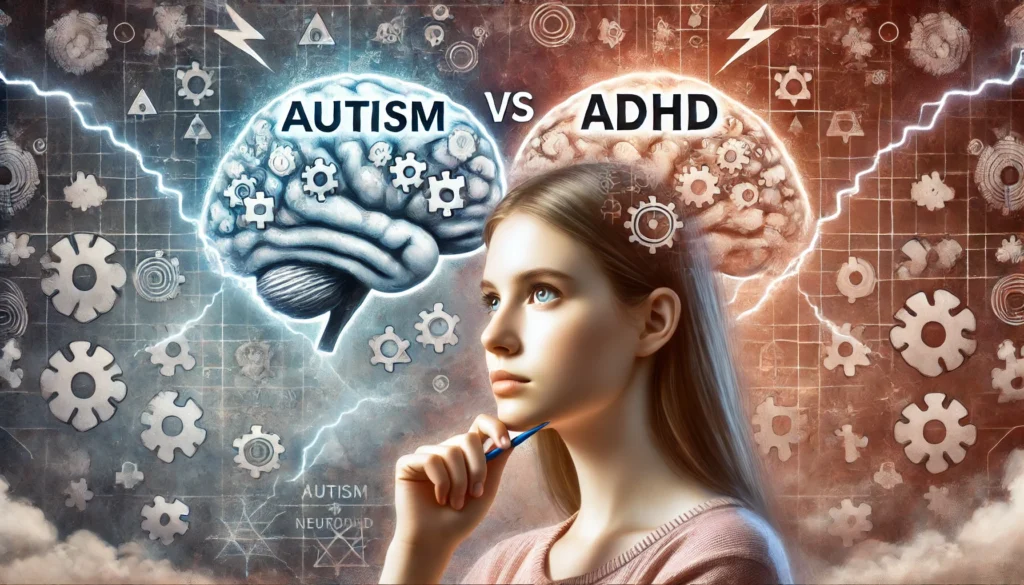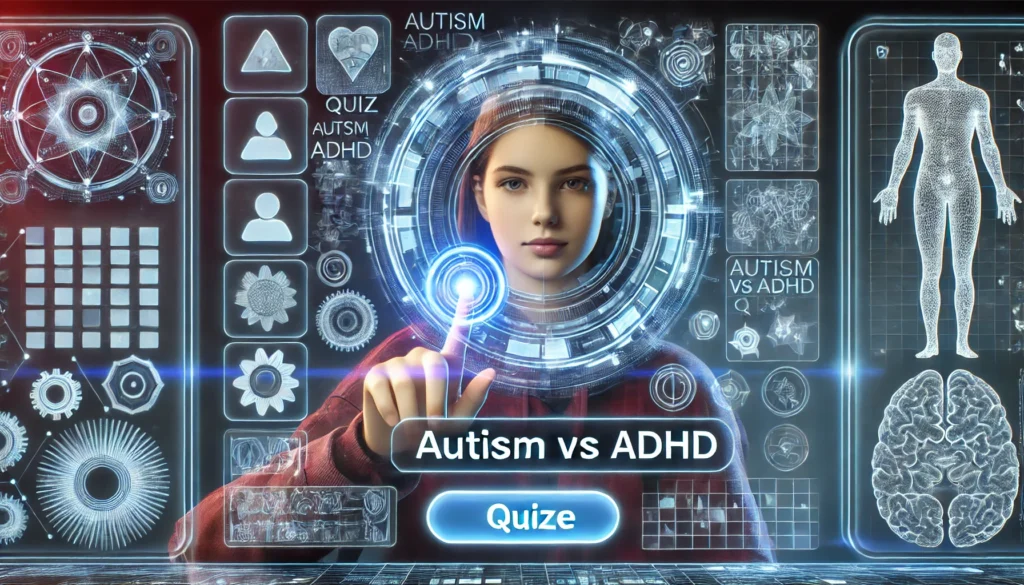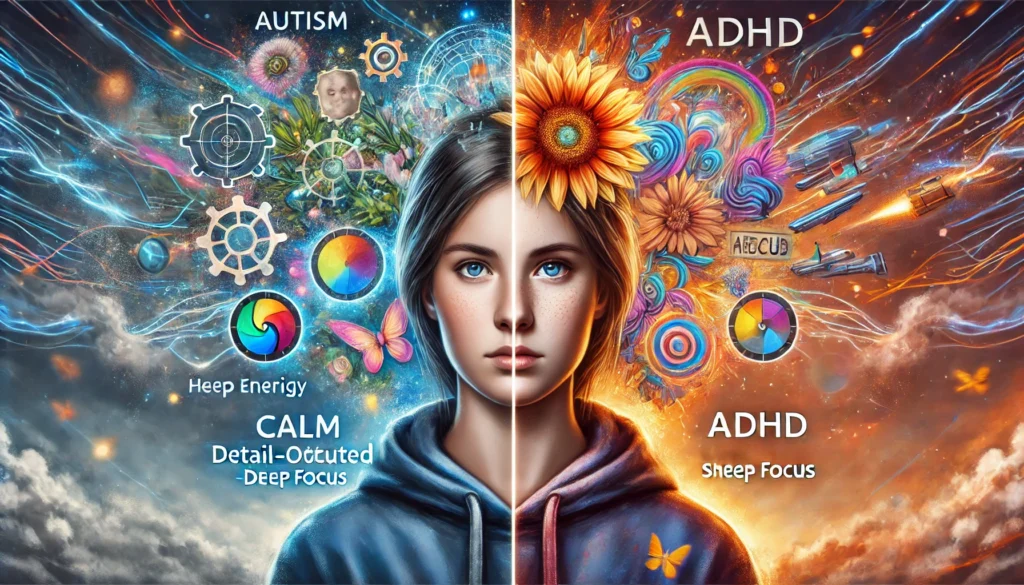Before diving into the specific symptoms, it is crucial to understand the core characteristics of both ASD and ADHD. Autism Spectrum Disorder is characterized by challenges with social skills, repetitive behaviors, and difficulties with communication and interaction. On the other hand, ADHD is primarily associated with persistent patterns of inattention, hyperactivity, and impulsivity.
You may also like: Enhancing Concentration: Strategies for ADHD
Core Characteristics of Autism Spectrum Disorder
Autism Spectrum Disorder, or ASD, is a complex developmental condition that typically appears in early childhood. The spectrum nature of autism means that individuals can display a wide range of symptoms and abilities.
- Social Communication Challenges: Individuals with autism often have difficulty with social interactions, which can manifest as trouble understanding social cues, maintaining eye contact, or engaging in typical back-and-forth conversations. This can lead to challenges in forming and maintaining relationships.
- Repetitive Behaviors: Repetitive movements, routines, and resistance to change are common in those with autism. These behaviors can range from simple hand flapping to complex rituals that must be performed in a specific order.
- Sensory Sensitivities: Many with autism experience heightened sensitivity to sensory input, such as sounds, lights, or textures, which can cause significant discomfort or distress.
Core Characteristics of Attention Deficit Hyperactivity Disorder
ADHD is a neurodevelopmental disorder that impacts attention, self-control, and executive functioning, which can affect an individual’s ability to succeed academically and socially.
- Inattention: This includes a short attention span, being easily distracted, and difficulty organizing tasks. Individuals may struggle to follow through on instructions or complete tasks.
- Hyperactivity: This is often characterized by an inability to sit still, constant fidgeting, or an excessive amount of energy. In adults, this may present as extreme restlessness or an inability to relax.
- Impulsivity: Impulsivity in ADHD can result in hasty actions without thought of the consequences, difficulties waiting for their turn, or interrupting conversations excessively.
The Overlapping Symptoms
While ASD and ADHD are distinct disorders, they share several overlapping symptoms, which can complicate diagnosis.
- Attention Difficulties: Both conditions can involve difficulties in sustaining attention, although the nature and cause of this inattention can differ.
- Social Challenges: Individuals with either condition might struggle with social interactions, albeit for different reasons. Those with autism may have difficulty understanding social cues, while those with ADHD might be too impulsive or inattentive to respond appropriately.
- Executive Functioning Issues: Both ASD and ADHD can affect executive functioning, which includes skills like planning, organizing, and time management.

Historical Context and Gender Differences
Historically, both autism and ADHD were predominantly studied in male populations. This male-centric research approach led to diagnostic criteria that are more reflective of how these disorders appear in boys. Consequently, many girls with autism or ADHD remain undiagnosed or are misdiagnosed with other conditions, as their symptoms may not align with the traditional male-centric models.
Male-Centric Research and Its Impact
For decades, the understanding of ASD and ADHD was largely based on studies conducted on boys. This skewed perspective has led to a significant gap in recognizing how these disorders manifest in girls.
- Diagnostic Criteria Development: Diagnostic criteria for both disorders were initially developed based on male presentations. This has resulted in a model that does not capture the subtleties of how symptoms may appear in females.
- Research Bias: The lack of representation of females in research studies has contributed to a misunderstanding of how these disorders affect girls, perpetuating stereotypes and leading to inadequate support and resources.
- The Consequence of Misdiagnosis: Girls with ASD or ADHD often face misdiagnosis or are diagnosed with conditions such as anxiety or depression, as their symptoms are not immediately recognized as neurodevelopmental.
The Camouflage Effect
Current trends in research are beginning to address these disparities. Studies have shown that girls with autism often exhibit more subtle social difficulties and may have a better ability to camouflage or mask their symptoms. Similarly, girls with ADHD may not display the hyperactivity often seen in boys, leading them to be overlooked.
- Social Camouflage in Autism: Many girls with autism develop strategies to mimic social behaviors, allowing them to blend in more easily with their peers. This can involve mimicking gestures, speech patterns, or interests to avoid standing out.
- Masking Behaviors: Masking involves suppressing autistic traits to conform to societal expectations. While this can help girls avoid social exclusion, it often leads to emotional exhaustion and increased anxiety.
- Underdiagnosis of ADHD: Girls with ADHD might exhibit less overt hyperactivity and instead display symptoms like excessive talking or emotional reactivity, which may be misinterpreted as personality traits rather than symptoms of a disorder.
Current Research and Future Directions
There is a growing awareness of the need for gender-sensitive diagnostic tools and research. This shift is crucial for improving the accuracy of diagnoses and the effectiveness of interventions.
- Inclusive Research Initiatives: More studies are including female participants, aiming to understand the full spectrum of symptoms and experiences across genders. This research is essential for developing diagnostic criteria that accurately reflect the experiences of girls.
- Development of Gender-Specific Tools: Efforts are underway to create assessment tools and checklists specifically designed to capture the unique presentation of ASD and ADHD in girls.
- Longitudinal Studies: Long-term studies tracking the development of girls with ASD and ADHD are providing valuable insights into how these conditions evolve over time and the effectiveness of various interventions.
Recognizing Autism in Girls
Girls with autism might display their symptoms differently, which can lead to unique challenges in diagnosis and support. Here are some common symptoms that differentiate autism in girls:
Social Interaction
Girls with autism often have a keen interest in social interaction but may struggle with the nuances of social communication. They might exhibit:
- Intense Focus on Specific Topics: While boys might fixate on objects or systems, girls often develop intense interests in areas that are socially acceptable, such as animals or celebrities. This can make their focus less noticeable and more easily dismissed as typical enthusiasm.
- Difficulty in Forming Friendships: While girls with autism may desire friendships, they might find it challenging to maintain them due to difficulty interpreting social cues. They might not understand unspoken rules or struggle to navigate the complexities of social hierarchies.
- Social Mimicry: To fit in, girls may imitate the social behaviors of their peers, even if they do not fully understand them. This mimicry can be exhausting and lead to misunderstandings about their social competencies.
Communication
Communication challenges in girls with autism can manifest as:
- Subtle Language Difficulties: Girls may have a broad vocabulary but struggle with understanding sarcasm or implied meanings. They might take things literally, leading to confusion in conversations with peers.
- Non-Verbal Communication: Girls might use gestures less frequently or inappropriately, which can hinder effective communication. Their facial expressions may not match their feelings, leading to misunderstandings.
- Expressive Language Delays: While some girls may excel in vocabulary, others may have delays in expressive language, making it difficult for them to convey their thoughts or emotions clearly.
Repetitive Behaviors and Interests
While repetitive behaviors are a hallmark of autism, in girls, these might be less overt or more socially acceptable, such as:
- Ritualized Play: Girls might engage in repetitive play patterns but these could be dismissed as typical childhood games. Their play might involve arranging toys in specific ways or creating detailed scenarios that must be followed precisely.
- Imaginative Play: Girls may use imaginative play as a means to express their interests repetitively. They might create elaborate stories or worlds that allow them to explore their interests in a controlled manner.
- Hobbies and Collections: Girls might develop intense interests in certain hobbies or collections, such as horses or dolls, spending a great deal of time on these activities.

Recognizing ADHD in Girls
ADHD in girls often goes unnoticed because their symptoms can be less disruptive than those seen in boys. However, it is essential to recognize these differences:
Inattention
Girls with ADHD are more likely to exhibit inattention rather than hyperactivity. Symptoms include:
- Daydreaming: Girls may appear to be daydreaming or ‘zoning out’ frequently. This can lead to academic difficulties, as they might miss important information during lessons.
- Disorganization: They might struggle with organizing tasks or managing time effectively. This can manifest as messy workspaces, missed deadlines, or difficulty following multi-step instructions.
- Forgetfulness: Forgetting to complete assignments, losing personal items, and difficulty remembering details can be more pronounced in girls with ADHD.
Hyperactivity and Impulsivity
Although less common, hyperactivity and impulsivity can still be present in girls, often manifesting as:
- Excessive Talking: Girls might talk excessively without realizing it. This can lead to social challenges, as they may dominate conversations or interrupt others.
- Impulsive Decision-Making: They may make hasty decisions without fully considering the consequences. This impulsivity can affect their relationships and academic performance.
- Fidgeting and Restlessness: While they may not display overt hyperactivity, girls might exhibit subtle signs like fidgeting, tapping, or an inability to stay seated for long periods.
Emotional Regulation
Girls with ADHD might have difficulties with emotional regulation, such as:
- Heightened Emotional Responses: Experiencing intense emotions and difficulty managing them. They may have strong reactions to minor events, leading to conflicts with peers or family members.
- Sensitivity to Criticism: Girls may be more sensitive to feedback, leading to feelings of inadequacy. This sensitivity can affect their self-esteem and willingness to take risks.
- Mood Swings: Rapid shifts in mood, from excitement to frustration, can be common. These mood swings can be challenging for both the girls and those around them to navigate.
The Importance of Accurate Diagnosis
Accurate diagnosis of autism and ADHD in girls is vital for providing appropriate support and interventions. Misdiagnosis or late diagnosis can lead to challenges in academic, social, and emotional development. Early identification and intervention can significantly improve outcomes for girls with these conditions.
The Consequences of Misdiagnosis
Misdiagnosis or delayed diagnosis can have long-term impacts on girls with autism or ADHD.
- Academic Challenges: Without proper support, girls may struggle academically, leading to frustration and disengagement from school. They may be perceived as lazy or disinterested rather than needing specific interventions.
- Social Isolation: Misdiagnosed girls might face social isolation as their peers misinterpret their behaviors. This can lead to loneliness and increased anxiety or depression.
- Emotional Difficulties: The stress of not understanding why they feel different can lead to emotional difficulties. Girls may develop low self-esteem or experience heightened anxiety.
Practical Advice for Parents and Caregivers
For parents and caregivers, understanding the subtle signs of autism and ADHD in girls is crucial. Here are some tips:
- Observe and Document Behaviors: Keeping a record of behaviors can help professionals make accurate diagnoses. Note any patterns, triggers, or changes over time to provide comprehensive information to healthcare providers.
- Seek Professional Evaluations: Consult with specialists who have experience in diagnosing neurodevelopmental disorders in females. Ensure that the professionals are aware of the unique presentations in girls.
- Advocate for Your Child: Be proactive in seeking support and resources from schools and healthcare providers. Attend meetings, ask questions, and ensure that your child’s needs are being met.
Tools and Resources
Several tools and resources can aid in recognizing and understanding these disorders:
- Autism vs ADHD in Females Quiz: Online quizzes can provide initial insights but should not replace professional evaluations. They can be a helpful starting point for discussions with healthcare providers.
- Do I Have Autism or ADHD Quiz Free: These quizzes can help individuals reflect on their experiences and discuss them with professionals. They offer a non-threatening way to explore potential symptoms.
- ADHD Autism Test: Comprehensive assessments by psychologists or psychiatrists are necessary for diagnosis. These tests consider a range of factors, including behavioral observations and developmental history.

Future Implications and Research Directions
As awareness of gender differences in autism and ADHD grows, future research is likely to focus on refining diagnostic criteria and developing gender-sensitive interventions. This could lead to better support systems and improved quality of life for girls with these conditions.
Evolving Diagnostic Criteria
The evolution of diagnostic criteria is critical to capturing the full range of symptoms experienced by girls with autism and ADHD.
- Incorporating Gender-Specific Symptoms: Future diagnostic criteria may include symptoms and behaviors more commonly seen in females, leading to earlier and more accurate diagnoses.
- Multidisciplinary Approaches: Combining insights from psychology, neuroscience, and education can lead to more comprehensive diagnostic tools that consider the diverse presentations of these disorders.
- Continuous Feedback from Affected Individuals: Listening to the experiences of girls and women with ASD and ADHD can inform the development of more accurate diagnostic criteria and interventions.
Developing Gender-Sensitive Interventions
Interventions that consider gender differences can improve outcomes for girls with autism and ADHD.
- Tailored Therapies: Developing therapeutic approaches that address the specific needs of girls, such as social skills training that takes into account the social pressures they face.
- Educational Adjustments: Schools can implement strategies that accommodate the learning styles of girls with these disorders, such as flexible seating arrangements or individualized learning plans.
- Parental and Teacher Training: Educating parents and teachers about the unique presentations of ASD and ADHD in girls can lead to more supportive environments both at home and in school.
Societal and Cultural Considerations
A broader understanding of the cultural and societal factors that impact girls with these disorders is crucial.
- Challenging Stereotypes: Raising awareness and challenging stereotypes about how autism and ADHD should look can lead to more inclusive and supportive communities.
- Promoting Acceptance and Understanding: Increasing public understanding of these disorders can reduce stigma and promote acceptance, allowing girls to feel more supported and understood.
- Supporting Diverse Voices: Encouraging the inclusion of diverse voices in research and advocacy can lead to a more comprehensive understanding of the challenges faced by girls with autism and ADHD.
In conclusion, understanding the distinctions between autism and ADHD in girls is essential for accurate diagnosis and effective intervention. By recognizing the unique ways these disorders manifest in females, we can provide better support and improve outcomes for girls affected by these conditions. As research continues to evolve, staying informed and advocating for gender-specific approaches will be key in ensuring that girls receive the care and support they need.
Further Reading:
ADHD Vs. Autism in Adults: What’s the Difference
Autism vs ADHD: What Are the Differences?
Important Note: The information contained in this article is for general informational purposes only, and should not be construed as health or medical advice, nor is it intended to diagnose, prevent, treat, or cure any disease or health condition. Before embarking on any diet, fitness regimen, or program of nutritional supplementation, it is advisable to consult your healthcare professional in order to determine its safety and probable efficacy in terms of your individual state of health.
Regarding Nutritional Supplements Or Other Non-Prescription Health Products: If any nutritional supplements or other non-prescription health products are mentioned in the foregoing article, any claims or statements made about them have not been evaluated by the U.S. Food and Drug Administration, and such nutritional supplements or other health products are not intended to diagnose, treat, cure, or prevent any disease.


